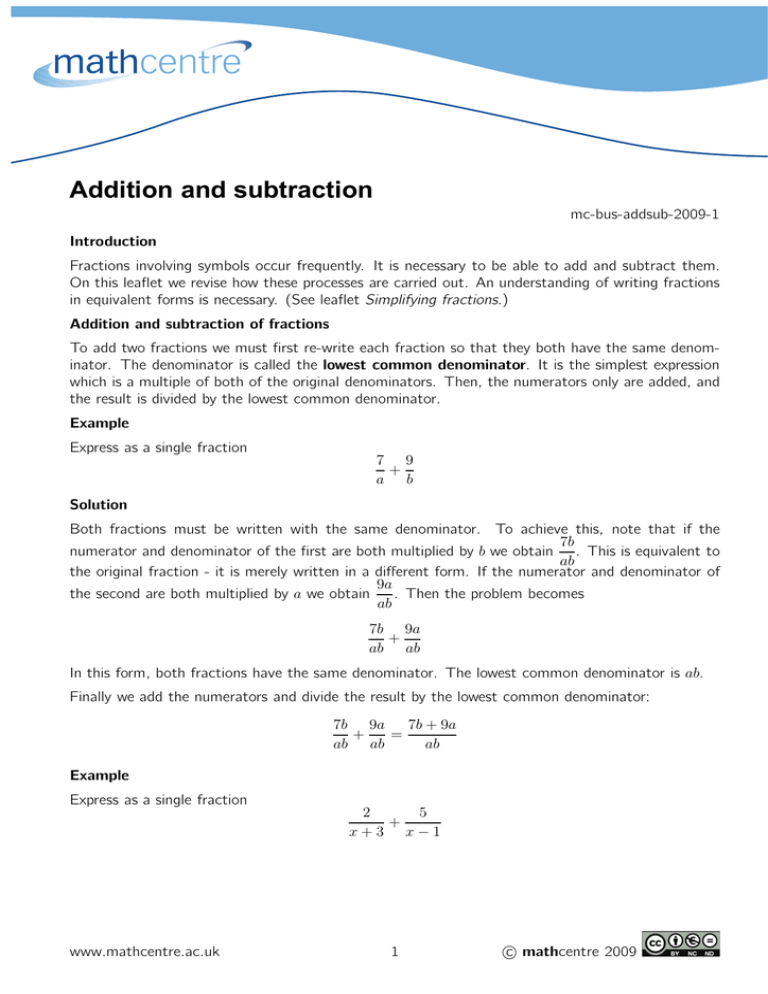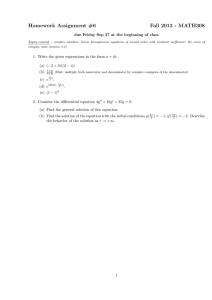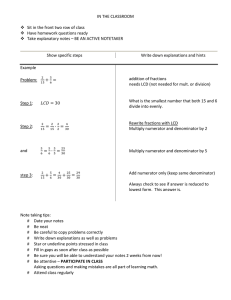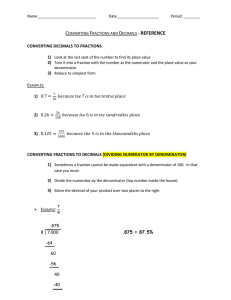Addition and subtraction
advertisement

Addition and subtraction mc-bus-addsub-2009-1 Introduction Fractions involving symbols occur frequently. It is necessary to be able to add and subtract them. On this leaflet we revise how these processes are carried out. An understanding of writing fractions in equivalent forms is necessary. (See leaflet Simplifying fractions.) Addition and subtraction of fractions To add two fractions we must first re-write each fraction so that they both have the same denominator. The denominator is called the lowest common denominator. It is the simplest expression which is a multiple of both of the original denominators. Then, the numerators only are added, and the result is divided by the lowest common denominator. Example Express as a single fraction 7 9 + a b Solution Both fractions must be written with the same denominator. To achieve this, note that if the 7b numerator and denominator of the first are both multiplied by b we obtain . This is equivalent to ab the original fraction - it is merely written in a different form. If the numerator and denominator of 9a . Then the problem becomes the second are both multiplied by a we obtain ab 7b 9a + ab ab In this form, both fractions have the same denominator. The lowest common denominator is ab. Finally we add the numerators and divide the result by the lowest common denominator: 7b + 9a 7b 9a + = ab ab ab Example Express as a single fraction www.mathcentre.ac.uk 2 5 + x+3 x−1 1 c mathcentre 2009 Solution Both fractions can be written with the same denominator if both the numerator and denominator of the first are multiplied by x − 1 and if both the numerator and denominator of the second are multiplied by x + 3. This gives 5 2(x − 1) 5(x + 3) 2 + = + x+3 x−1 (x + 3)(x − 1) (x + 3)(x − 1) Then, adding the numerators gives 2(x − 1) + 5(x + 3) (x + 3)(x − 1) which, by simplifying the numerator, gives 7x + 13 (x + 3)(x − 1) Example 3 2 Find + x + 1 (x + 1)2 Solution The simplest expression which is a multiple of the original denominators is (x + 1)2 . This is the lowest common denominator. Both fractions must be written with this denominator. 2 3(x + 1) 2 3 + = + 2 2 x + 1 (x + 1) (x + 1) (x + 1)2 Adding the numerators and simplifying we find 3(x + 1) 2 3x + 3 + 2 3x + 5 + = = 2 2 2 (x + 1) (x + 1) (x + 1) (x + 1)2 Exercises 1. Express each of the following as a single fraction: a) 3 4 + x1 , b) 1 a − 2 , 5b c) 2 x2 + x1 , d) 2 + 1 . 3x 2. Express as a single fraction: a) 2 x+1 + 3 , x+2 b) 2 x+3 + 5 , (x+3)2 c) 2+x , x2 2x+11 , (x+3)2 c) c) 3x x−1 + x1 , d) 1 x−5 − 3 , x+2 e) 1 2x+1 − Answers 1. a) 3x+4 , 4x 2. a) 5x+7 , (x+1)(x+2) b) 5b−2a , 5ab b) www.mathcentre.ac.uk d) 6x+1 . 3x 3x2 +x−1 , x(x−1) d) 17−2x , (x+2)(x−5) 2 13x+4 e) − (x+3)(2x+1) . c mathcentre 2009 7 . x+3






